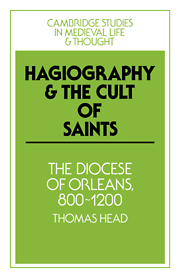Book contents
- Frontmatter
- Contents
- List of figures and maps
- Acknowledgements
- List of abbreviation
- INTRODUCTION
- 1 THE CAROLINGIAN PERIOD
- 2 THE CAPETIAN PERIOD
- 3 THE IDEAL OF SANCTITY: FORMATION, IMITATION, AND DISSEMINATION
- 4 THE POSTHUMOUS PATRONAGE OF THE SAINTS
- 5 SAINTLY PATRONAGE AND EPISCOPAL AUTHORITY AT THE ABBEY OF MICY
- 6 SAINTS, ABBOTS, AND ECCLESIASTICAL POLITICS AT FLEURY AND PITHIVIERS
- CONCLUSION
- Bibliography and references
- Index
3 - THE IDEAL OF SANCTITY: FORMATION, IMITATION, AND DISSEMINATION
Published online by Cambridge University Press: 22 September 2009
- Frontmatter
- Contents
- List of figures and maps
- Acknowledgements
- List of abbreviation
- INTRODUCTION
- 1 THE CAROLINGIAN PERIOD
- 2 THE CAPETIAN PERIOD
- 3 THE IDEAL OF SANCTITY: FORMATION, IMITATION, AND DISSEMINATION
- 4 THE POSTHUMOUS PATRONAGE OF THE SAINTS
- 5 SAINTLY PATRONAGE AND EPISCOPAL AUTHORITY AT THE ABBEY OF MICY
- 6 SAINTS, ABBOTS, AND ECCLESIASTICAL POLITICS AT FLEURY AND PITHIVIERS
- CONCLUSION
- Bibliography and references
- Index
Summary
In the statute of 871, Bishop Walter suggested that the ‘fathers’ of the diocese of Orléans were to be active in the affairs of the people of his diocese. One of the chief means by which such ancient saints could become present again was through the vitae of those saints. Portions of those texts were read out during the liturgy on the feastday of the saint. By reading or hearing these works – for, as Bertholdus of Micy had made clear, the ‘audience’ of hagiography included both readers and auditors – living Christians came to know the personality and power of these patrons. The vitae of the saints described their virtus, a word which could equally mean spiritual virtue and miraculous powers. The ways in which the saints had exhibited this virtus was also significant. The ‘fathers’ of Bishop Walter's list were either bishops or monks; they had gained their reputation for sanctity through the traditional paths of the ecclesiastical hierarchy or of asceticism. In their vitae hagiographers described and disseminated an ideal of holiness while they implicitly grounded the religious communities of the diocese firmly in the patronage provided by the ‘fathers’.
The virtus of the saints had gained them entrance into heaven and thus provided those saints with their authority. That authority could help the living in their quest for salvation. Bertholdus described their relationship:
Divine providence provided [us] a shepherd, namely the most blessed Maximinus, who was given to us just as will be explained. […]
- Type
- Chapter
- Information
- Hagiography and the Cult of SaintsThe Diocese of Orléans, 800–1200, pp. 102 - 134Publisher: Cambridge University PressPrint publication year: 1990



